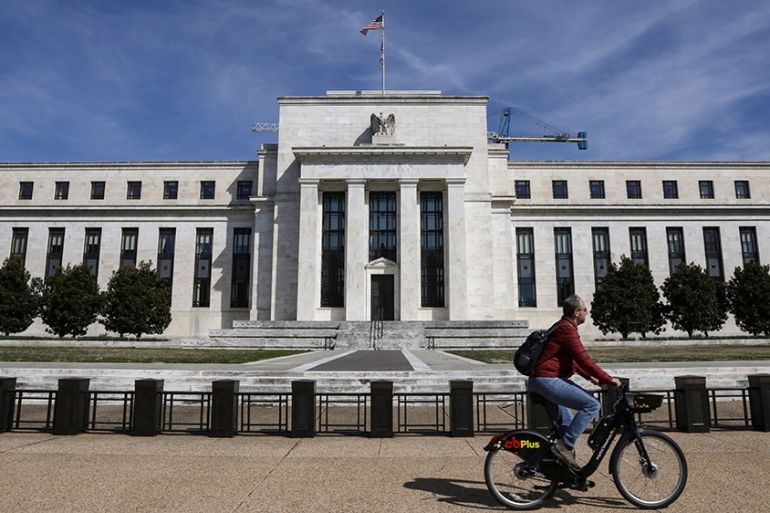US Fed cuts interest rates but gives mixed signals on next move
The rate cut fell short of the more aggressive reduction in borrowing costs that Trump had demanded from Fed officials.

The United States Federal Reserve cut interest rates by a quarter of a percentage point for the second time this year on Wednesday in a widely expected move meant to sustain a decade-long economic expansion. But the Fed gave mixed signals about what may happen next.
Shortly after the decision was announced, US President Donald Trump, who has been pushing the Fed to lower borrowing costs more aggressively, took to Twitter to criticise Wednesday’s policy decision.
Keep reading
list of 4 itemsBoeing hit with 32 whistleblower claims, as dead worker’s case reviewed
US imposes new sanctions on Iran after attack on Israel
A flash flood and a quiet sale highlight India’s Sikkim’s hydro problems
“Jay Powell and the Federal Reserve Fail Again,” Trump tweeted. “No ‘guts,’ no sense, no vision! A terrible communicator!”
Last week, Trump called on the Federal Reserve policymakers to push rates to zero or less, referring to them as “boneheads” and accusing them of putting the economic recovery in jeopardy.
The US central bank on Wednesday also widened the gap between the interest it pays banks on excess reserves and the top of its policy rate range – a step taken to smooth out problems in money markets that prompted a market intervention by the Federal Reserve Bank of New York this week.
In lowering the benchmark overnight lending rate to a range of 1.75 percent to 2.00 percent on a seven-to-three vote, the Fed’s policy-setting committee nodded to ongoing global risks and “weakened” business investment and exports.
Though the US economy continues growing at a “moderate” rate and the labour market “remains strong”, the Fed said in its policy statement that it was cutting rates “in light of the implications of global developments for the economic outlook as well as muted inflation pressures”.
With continued growth and strong hiring “the most likely outcomes”, the Fed nevertheless cited “uncertainties” about the outlook and pledged to “act as appropriate” to sustain the expansion.
New projections showed the median estimate by policymakers is for rates to stay within the new range through 2020.
However, in a sign of ongoing divisions within the Fed, seven of 17 policymakers projected one more quarter-point rate cut in 2019.
Five others, in contrast, see rates as needing to rise by the end of the year.
The divisions were reflected in dissents that came from both hawks and doves.
Federal Reserve Bank of St Louis President James Bullard wanted a more aggressive half-point cut, while Boston Fed President Eric Rosengren and Kansas City Fed President Esther George preferred to leave rates where they are, and not cut at all.
There was little change in policymakers’ projections for the economy, with growth seen at a slightly higher 2.2 percent this year and the unemployment rate projected to be 3.7 percent through 2020. Inflation is projected to be 1.5 percent for the year, below the Fed’s two percent target, before rising to 1.9 percent next year.
The Fed also cut rates in July, the first such move since 2008.
Fed officials have said the rate cuts are justified largely because of risks raised by Trump’s trade war with China, a global economic slowdown and other overseas developments.
Their aim, they say, is to balance the potential need for lower rates against the risk that cheaper money may cause households and businesses to borrow too much, as happened in the run-up to the financial crisis more than a decade ago.